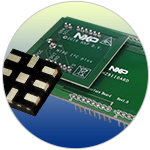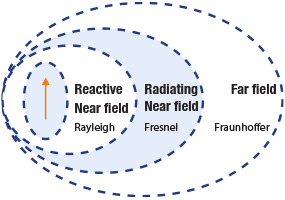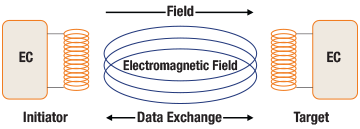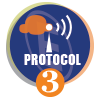
Also Available:
According to the NFC Forum, the body that maintains NFC protocols and standards, "NFC technology enables simple and safe two-way interactions between electronic devices, allowing consumers to perform contactless transactions, access digital content, and connect electronic devices with a single tap. NFC complements popular wireless technologies such as Bluetooth. NFC also enables devices to share information at a distance that is less than 10 centimeters. Users can share business cards, make transactions, access information from a smart poster or provide credentials for access control systems with a simple touch."
The above definition does not tell us much about the technology, apart from it working at a range of less than 10 cm, nor does it say much about how it works (besides simple touch). In this learning module, we are going to look at NFC in more detail, so that we are able to understand some of the basics of the technology and how it works.
2. Objectives
The main objective of this learning module is to introduce you to NFC.
Upon completion of this module, you will be able to:
 Explain the difference between Near Field and Far Field Communication
Explain the difference between Near Field and Far Field Communication
 Describe some applications of NFC
Describe some applications of NFC
 Explain some key constraints for NFC applications
Explain some key constraints for NFC applications
 Discuss the features of some standard NFC-based apps
Discuss the features of some standard NFC-based apps
 Discuss passive and active NFC
Discuss passive and active NFC
NFC is a different kind of wireless. To begin with, it's a proximity technology, which means it only works when two devices are brought close together. Eavesdropping is a near impossibility. What's more, NFC is unique in the way it uses energy. Or, more to the point, the way it doesn't. Only one of the two devices needs to be powered for an interaction to take place. The first can power the second, so the second can save its battery for other things—or not have a battery at all.
NFC is an evolution of contactless smartcard technology but, unlike its predecessor, which can only communicate in one direction, NFC supports bidirectional interactions. That opens up a whole new range of possibilities, from the simple exchange of business cards to more sophisticated things like personalized transactions, loyalty programs, and devices that can commission and configure themselves. Also, because NFC is fully compatible with the established, trusted infrastructure behind contactless smartcards, NFC is ready to go.
NFC Quick Facts
|
|
NFC stands for Near Field Communication. It is a close-range, Radio Frequency technology that allows for simple data transfer between NFC devices at extremely short distance (usually on the order of a few centimeters).
Even though NFC is a contactless Radio technology (i.e., it works on Radio Frequency, RF, through wireless communication), we as users often think of NFC being a touch or contact technology because we have to touch the card or phone to the pay station (touch payment), or touch two phones together in order to share info between phones (touch contacts). The "touch" in these instances is to aid us in remembering that the two corresponding NFC devices need to be very close together for the desired communication to take place. In actuality, no "touch" is needed for the NFC to work.
In addition to payments and exchanging contacts, NFC has a growing variety of applications. We will discuss these briefly later in this learning module. For now, let's discuss the NF portion of NFC.
The term 'Near Field' describes the operational region in which electromagnetic induction can occur. For electromagnetic fields governed by Maxwell's equation, we know that both a magnetic and an electric field exist and may propagate in free space. At very short distances, the received power can be nearly equal to the transmitted power due to the presence of quasi-stationary waves that can allow magnetic or electric coupling.
We are used to thinking about electromagnetic induction, such as in transformer action. But at close range, induction can also be used for the purposes of communication, and this is called the Near Field or the Rayleigh zone. This happens at distances that are less than λ/2π. (See Figure 1)
How does this work? At longer distances, the electric portion of the electromagnetic field becomes dominant and magnetic coupling (such as used by a transformer) is no longer possible. But there still exists a radiating electromagnetic field propagating through space, and this radiation is used in communication. The zone, which occurs at distances greater than λ/2π, is called the Fraunhoffer zone; this is where traditional Radio Frequency (RF) communications take place by utilizing radio wave propagation. Traditional RF technologies can be thought of as Far Field Communication. The zone that is in between these two, where the distance is approximately equal to the wavelength, λ, can be considered as the intermediate zone, called the Fresnel zone.
The precise physics of Near Field and Far Field zones is a bit more complicated. In this learning module, we have distilled it to the extent that is relevant to our discussion of communication. There is a great deal of disagreement in the scientific and engineering community regarding the precise separation point between near and far field; the zones discussed above are useful but not necessarily definitive. Regarding the distinction between near field and far field communication, you may simply want to think of whether induction or radiation is being used as the basis for communication. Or, another way of remembering it: inductive Near Field for NFC and radiative Far Field for propagation-based radios.
The core driving principle of NFC, and also what differentiates it from regular, propagation-based, RF communications, is magnetic induction1. As shown in the Figures 2 and 3, there is an initiator device that generates an electromagnetic field around it. A target device within range of the field has the potential to experience magnetic induction. The basic concept here is that the magnetic field can be modulated by the transmitter and the modulated changes in the magnetic field can be picked up or measured by the receiver.
This explains one directional communication (from initiator to target) quite easily, but how does bidirectional communication occur?
Refer to Figure 3. Once the inductive link has been set up, there is mutual inductance between the coils. A change in current in one coil results in a voltage being induced in the other coil. Traditional inductive applications, such as transformers, usually change things in a primary coil to have resultant effects in the secondary coil; however, once the inductive link has been set up, bidirectionality is possible. For example, in the case of an RFID reader reading the information of an IC chip, there is actually information being extracted from a passive secondary device.
Mutual Inductance is the driving force behind NFC communication. Table 1 illustrates the different possibilities:
| Device 1 | Device 2 | Field | Communication mode | Comments |
|---|---|---|---|---|
| Active | Active | Generated between both devices | Active | Either device can be the initiator or target (bidirectional) |
| Active | Passive | Field generated by Device 1 | Passive | Device 1 is initiator |
| Passive | Active | Field generated by Device 2 | Passive | Device 2 is initiator |
Table 1: Examples of Directional and Bi-Directional NFC Communication
Though the second and third row in the table seem to be identical, we are separating them out depending on which direction information is traveling (i.e., Device 1 or Device 2 being the initiator). Of course, the first row indicates bidirectional communication. The third row would be a situation similar to RFID. The RFID reader generates the field but the information is obtained from the tag.
NFC operates at 13.56 MHz. However, remember that we are interested in magnetic induction at that frequency. One of the interesting aspects of the 13.56 MHz frequency is that it has low interaction with human and animal tissue, which means that NFC is a good choice for wearables or other kinds of human proximity applications.
1 Is NFC the same as Near Field Magnetic Induction (NFMI)? Theoretically, yes; however, NFMI is being used as a marketing term for a specific set of NFC that increases the range. In this learning module, we will refrain from using that terminology.
There are three major operating modes in NFC. They are the Read/Write (RW), the Peer-to-Peer (P2P), and the Card Emulation (CE) mode.
Read/Write Mode (RW)
In this mode, the initiator can read basic info from, or write basic info to, a target device. In Read/Write Mode, the system performs the functions of a contactless reader/writer. The system's NFC IC interacts with an NFC-enabled device—such as a contactless smartcard, an NFC tag, or an NFC-enabled smartphone (operating in Card Emulation Mode)—and either reads data in from the device or writes data out to it. This mode is used to get information or initiate an action.
 Power savings: The NFC-enabled device that initiates the transaction generates an RF field, and then reads data from or writes data to a second NFC-enabled device. The second device does not generate its own RF field, but instead modulates the RF field created by the initiator. This is an important distinction, because it means the second device uses power from the initiator and doesn't need its own battery.
Power savings: The NFC-enabled device that initiates the transaction generates an RF field, and then reads data from or writes data to a second NFC-enabled device. The second device does not generate its own RF field, but instead modulates the RF field created by the initiator. This is an important distinction, because it means the second device uses power from the initiator and doesn't need its own battery.
 Secure transactions: To increase the security of Read/Write Mode, a Secure Access Module (SAM), which acts as a secure crypto coprocessor, can be used to encrypt data. The SAM also verifies the encrypted data for authenticity before the transaction (such as an online purchase or access to a building) can proceed.
Secure transactions: To increase the security of Read/Write Mode, a Secure Access Module (SAM), which acts as a secure crypto coprocessor, can be used to encrypt data. The SAM also verifies the encrypted data for authenticity before the transaction (such as an online purchase or access to a building) can proceed.
Peer-to-Peer Mode (P2P)
In this situation, both ends of NFC are active devices. This is suited for information transfer, from contacts to large files such as media. Peer-to-Peer Mode is used to establish a two-way communication channel between a pair of NFC-enabled devices. Each NFC-enabled device serves as an endpoint, meaning the two systems can initiate a communication as equals, or peers. This mode uses either a passive or active communication scheme.
 Two-way interactions: The two-way nature of Peer-to-Peer Mode enables more sophisticated interactions between devices, so you can, for example, pair with Bluetooth or Wi-Fi, exchange business cards with a colleague, or receive frequent-flyer points when purchasing an airline ticket.
Two-way interactions: The two-way nature of Peer-to-Peer Mode enables more sophisticated interactions between devices, so you can, for example, pair with Bluetooth or Wi-Fi, exchange business cards with a colleague, or receive frequent-flyer points when purchasing an airline ticket.
 Power savings: Peer-to-Peer Mode can use a passive communication scheme. Only one device needs to be active, drawing power to generate the necessary RF field. The second device can remain passive, acting only as a target and modulating the field. Working in passive mode is a significant benefit, from the standpoint of power consumption, and is one of the requirements for compliance with the NFC Forum, the primary standards body for NFC technology.
Power savings: Peer-to-Peer Mode can use a passive communication scheme. Only one device needs to be active, drawing power to generate the necessary RF field. The second device can remain passive, acting only as a target and modulating the field. Working in passive mode is a significant benefit, from the standpoint of power consumption, and is one of the requirements for compliance with the NFC Forum, the primary standards body for NFC technology.
Card Emulation (CE)
This is the mode that closely mimics existing use cases for contactless payments. It is important to remember that this is different than chip-card technology, which uses EMV chip technology. Card Emulation Mode lets the system behave as an ISO/IEC 14443-compliant contactless smartcard. This means that the NFC-enabled device can be used in the existing contactless card infrastructure, for things like ticketing, access control, transit, tollgates, and contactless payments.
 Power savings: Card Emulation Mode saves power by using passive communication. In this mode, the smartcard or NFC device modulates the RF field generated by the initiator of the transaction, which is likely to be a contactless reader in a building-access or payment application. Since the smartcard or NFC device does not generate its own RF field, the transaction is highly efficient. Battery-driven NFC devices that function exclusively in Card Emulation Mode consume very little power, since the system requires only enough energy to drive the onboard microcontroller. This results in very long lifetime in the field.
Power savings: Card Emulation Mode saves power by using passive communication. In this mode, the smartcard or NFC device modulates the RF field generated by the initiator of the transaction, which is likely to be a contactless reader in a building-access or payment application. Since the smartcard or NFC device does not generate its own RF field, the transaction is highly efficient. Battery-driven NFC devices that function exclusively in Card Emulation Mode consume very little power, since the system requires only enough energy to drive the onboard microcontroller. This results in very long lifetime in the field.
Incidentally, though EMV may seem like it suggests some complex terminology (like Electronic Money Verification), it actually stands for Europay, MasterCard, Visa, the original inventors of the technology.
The passive communication scheme applies to any of the three NFC operating modes: Read/Write, Passive Peer-to-Peer, and Card emulation modes. The initiating device produces a 13.56 MHz carrier field, and the target device, when introduced to this field, uses it to draw energy. The initiator transfers data by directly modulating the field, while the target transfers data by load-modulating the field. This method, required by the NFC Forum, is compatible with other contactless smartcard formats, including ISO/IEC 14443.
The active communication scheme applies to the Active Peer-to-Peer mode. The initiator and the target both generate an RF field. Each side transmits data by modifying its own field with Amplitude Shift Key (ASK) modulation. To avoid collisions, only the sending device emits an electromagnetic field. The receiving device switches off its field to listen. The send/receive roles can be reversed as needed to support the transaction.
NFC delivers short-range communication, similar to Bluetooth and Wi-Fi, but with the ability to store and transmit data in much the same way that RFID tags and contactless smartcards do. Here's how NFC compares to other wireless technologies.
| Technology | Frequency | Range | Active/Passive | Devices & Applications |
|---|---|---|---|---|
| NFC (ISO/IEC 18092, NFC Forum) | 13.56 MHz | 10cm | A/P | Smartphones, tablets, portable devices in a peer-to-peer network |
| Contactless (proximity) smartcards (ISO/IEC 14443) | 13.56 MHz | 10cm | P | Ticketing, payment, access, passports, etc. |
| RFID (ISO/IEC 18000) | LF (120 to 150kHz) HF (13.56 MHz) UHF (433 to 900MHz) | < 40m | A/P | Tagging and tracking of goods and items for manufacturing, logistics, retail, etc. |
| IrDA | Infrared | < 1m | A | Remote controls, mobile phones, computers |
| Bluetooth (IEEE 802.15.1) | 2.4 GHz | > 10m | A | Smartphones, tablets, laptops, audio equipment, printers, other devices in a personal area network (PAN) |
| Wi-Fi (IEEE 802.11) | 2.4 GHz | > 100m | A | Smartphones, tablets, laptops, routers, other devices in a local area network (LAN) |
| ZigBee (IEEE 802.15.4) | 2.4 GHz | > 100m | A | Lighting networks, home automation, industrial control |
| 2/2.5/3G cellular | 450 MHz to 2.7 GHz | Several km | A | Industrial devices, eMeters, Internet of Things (IoT) devices |
| 4G cellular | 450 MHz to 2.7 GHz | Several km | A | Smartphones, tablets |
Table 2: Comparison of NFC and other Wireless Technologies
In this section, we will summarize five NFC use cases.
Service Initiation
In this use case, an NFC-enabled mobile phone can touch on an NFC tag to initiate some service on the mobile phone, such as downloading an app, launching an app or browser, playing a video, etc. This could be used in a place like a conference where the tag could be located at a booth and touching the tag provides the user with more information. Many applications that have traditionally used QR tags can now be replaced with this kind of NFC use case. This is an example of RW mode operation.
Information Transfer/Sharing
This is the classic situation in which two NFC-enabled phones can exchange information. This is especially relevant to transferring content from an old phone to a new phone, exchanging pictures with your friends, or exchanging contact information with someone you are networking with. The P2P mode applies for this use case.
Device Connection Configuration
We have all been in a situation where we go to a new place and struggle to find the relevant information for setting up the Wi-Fi, or we have wrestled with setting up Bluetooth connections (press this button... hold for 5 seconds... wait for the green light to flash...). In these situations, NFC can step in as a savior. Touching two devices that are NFC-enabled can enable them to exchange configuration more easily (both RW or P2P mode can work here). A café could attach a tag near the register for the Wi-Fi credentials, for example.
Payment
Clearly, this is the application for CE mode. This is an alternative to Chip Card (EMV) payments, where one would touch an NFC-enabled mobile phone to an NFC-enabled register (reader). This is the basis of technology such as Apple Pay or Android Pay.
Travel and Ticketing
From airline travel to concert attendance, an NFC-enabled mobile phone can provide the needed authentication/check-in. Though primarily CE mode, other modes may also apply.

Figure 4: NXP NTAG I2C plus is a family of connected NFC tags that combine a passive NFC interface with a contact I2C interface, along with energy harvesting capabilities. In this example, the NTAG I2C plus connects to the MCU via the I2C serial bus interface. The NFC-enabled mobile device connection to the MCU via the NFC interface, using the I2C as the communication conduit.
We have already mentioned some key NFC applications in the previous section when discussing NFC use cases. In this section, let us look at a few additional application areas for NFC.
Medical
As noted earlier, NFC operates at a frequency that has extremely low tissue absorption. This makes NFC an ideal choice for medical applications. These can range from easy patient tracking to biomedical tracking.
Transportation
Beyond the NFC use case discussed for mobile based ticketing, NFC has also been applied to touch ticketing on transportation systems. NFC has been used in the US in public transit systems in Chicago (CTA) and New York City (MTA).
Location-based Services
The fact that an NFC tag can be applied to a location enables a range of possibilities for delivering location specific information. This is a broader generalization of the Service Initiation use case. NFC can enable location specific information ranging from menus at a restaurant, directions at a kiosk, exhibit information at a museum, and many more.
Asset tagging
Piggybacking on RFID applications of asset tagging, NFC has great potential in a range of asset tagging applications.
Enhanced Customer Support (Asset tagging enhanced)
Imagine being on your computer and calling customer support about a problem or issue with your device. You are asked to find the serial number and you end up going through a harrowing process of locating the physical sticker with a serial number on your device but finding that the number has been scratched off through wear and tear. To avoid going through this hassle, if you had an electronic NFC tag, you could look up the serial number identification quickly and easily.
Secure Authentication
An NFC tag, whether on a standalone card or set up on a mobile phone can be an effective authentication aid, especially when included in Two Factor Authentication (TFA) schemes.
There are four organizations you should be aware of that work on NFC standards. We will briefly summarize them in this section.
 ISO/IEC: There are two important NFC specifications: ISO/IEC 14443 and ISO/IEC 18000-3. The ISO/IEC 14443 specification defines the ID cards used to store information (e.g., NFC tags). ISO/IEC 18000-3 specifies the RFID communication used by NFC devices.
ISO/IEC: There are two important NFC specifications: ISO/IEC 14443 and ISO/IEC 18000-3. The ISO/IEC 14443 specification defines the ID cards used to store information (e.g., NFC tags). ISO/IEC 18000-3 specifies the RFID communication used by NFC devices.
 GSMA: The GSMA's NFC program is designed to stimulate the global commercial deployment of UICC-based NFC services, which have the potential to generate value for mobile operator customers.
GSMA: The GSMA's NFC program is designed to stimulate the global commercial deployment of UICC-based NFC services, which have the potential to generate value for mobile operator customers.
 StoLPAN: A cross industry association working on key issues related to the establishment of an open, interoperable NFC service environment.
StoLPAN: A cross industry association working on key issues related to the establishment of an open, interoperable NFC service environment.
 NFC Forum: The NFC Forum provides specifications and programs to create a highly stable framework for extensive NFC application development, seamless, interoperable solutions, secure NFC-enabled and transactions.
NFC Forum: The NFC Forum provides specifications and programs to create a highly stable framework for extensive NFC application development, seamless, interoperable solutions, secure NFC-enabled and transactions.
*Trademark. NXP is a trademark of NXP Corp. Other logos, product and/or company names may be trademarks of their respective owners.

Shop our wide range of NFC components, application specific MCUs, NFC Reader ICs, NFC controller boards, NFC tag starter kits, NFC interfaces, and other development boards.
Test Your KnowledgeBack to Top
Are you ready to demonstrate your NFC Essentials knowledge? Then take a quick 15-question quiz to see how much you've learned from this Wireless Protocol 3 Learning Module.
To earn the Wireless Protocol 3 Badge, read through the module to learn all about Near Field Communication (NFC), attain 100% in the quiz at the bottom, leave us some feedback in the comments section, and give the module a star rating.







